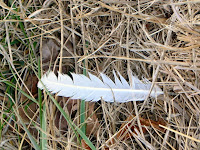Humans have appreciated the beauty of birds' feathers since before recorded history. Both native Americans and some Pacific cultures incorporated feathers into their ritual dress. As I examine even a single one of my relatively simple feathers from a Blue Jay or Mockingbird, I can see why: The feather's combination of rigidity and softness to the touch. The feather's simple elegance of design with a striking contrast of colors.
 |
| Walt Whitman |
Thinking about this matter of found feathers, the phrase that comes to my mind is "designedly dropped." It's a phrase Walt Whitman uses as he reflects on the wonder of a handful of grass brought to him by a child who asks the child's perennial question, "What is this?" Whitman, confessing to the reader that he cannot say ultimately what grass is (so wondrous it seems), contents himself with imaginative musings about what this natural object from the Creator might be. This is where Whitman likens the Nature-object to God's initialed handkerchief "designedly dropped, / Bearing the owner's name... that we may see and remark, and say Whose?"
To me, this mystery of feathers (or of a blade of grass) goes right to the heart of our spiritual relation to Nature. There is a paradox: I know that God did not intentionally drop that feather on the path along which I was about to walk so that I might find it. And I know that the symmetrical tidiness of the rows of thin branches projecting from a feather's stem was not created so that I might marvel. Nor were the colored designs created in order that I might enjoy their beauty.
Nevertheless, our human brains and cultures evolved so that we might engage the world in a way that unites our minds and hearts with the fascinating features of the world. I think one hymn writer spoke to this when that hymnist wrote of "the mystic harmony linking sense to sound and sight."
~~~
(The lines from the hymn are from
"For the Beauty of the Earth," lyrics by Folliott Sandford Pierpoint, 1864.)
"For the Beauty of the Earth," lyrics by Folliott Sandford Pierpoint, 1864.)
(Portrait of Walt Whitman is in public domain because its copyright has expired.)


1 comment:
When I was a child, I sometimes liked to pick up acorns. I admit that they were not as colorful or intricate as feathers, but for me as a child they were neat. The acorns looked like little heads wearing caps. They were fun! I can't imagine what I would have thought if I had come across one of the huge kinds of acorns that are made by burl oaks. (I never saw one of them until I was an adult.)
Post a Comment